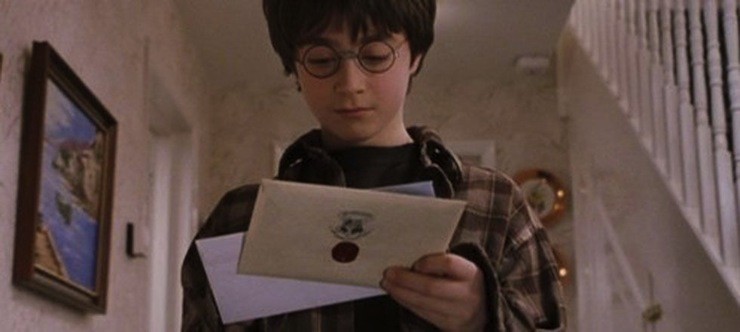Who among us wasn’t delighted by the scene, early in Harry Potter and the Sorcerer’s/Philosopher’s Stone, when Harry finally gets to open his letter? It is, to my mind, one of the most evocative images within the vividly drawn world of Harry Potter, and I believe that moment is memorable for a very specific reason: we are all Muggle-borns. When he gets his letter, Harry does not know about Hogwarts, and we would have been as surprised as he is to find out we need not go to middle school; that we’d be picking up quills, parchment, and a cauldron instead of pens and notepads.
I’ll confess that my first year of college, when I was feeling lost and lonely, more than once I wished an owl would come with a letter for me, letting me know I was supposed to be somewhere far more exciting than where I was.
I’m fairly certain I’m not the only Harry Potter enthusiast who’s felt this way about Hogwarts, given the vast online fandom, including Pottermore, not to mention the immersive theme park—and to my mind, it’s not just because those who go to Hogwarts learn actual magic spells. No, I believe part our collective desire to go to Hogwarts has a lot to do with the fact that at Hogwarts is in many ways the ideal school experience. Students matter. The classes are small. The masters are (for the most part) knowledgeable and encourage hands-on learning, and the school is run by a headmaster who is passionate about young people’s education. What you learn is not only interesting, it’s useful; with the exception of maybe Professor Binns’ History of Magic class, no one really questions why a certain subject is taught at Hogwarts. And every single day is an adventure—a real adventure, meaning, not always safe.
J.K. Rowling’s engrossing and engaging depiction of British school life is hardly a standalone work. Rather, it fits into the long tradition of “school stories,” in particular, those that came after Thomas Hughes’ wildly popular Tom Brown’s School Days (1857), which shaped what we recognize as the modern expression of the school novel. Themes such as sportsmanship, independence, and the development of moral character through hardship now almost always appear (or are parodied), as do the now-stock characters of wise headmasters, bullies, and loyal best friends.
In the context of Harry Potter, the above might call to mind anything from Quidditch matches to a certain Gryffindor with a terrier Patronus. There are many similarities between the Harry Potter novels and Tom Brown, but that novel isn’t the only identifiable influence on Rowling’s series. There is another schoolboy whose educational experience very obviously inspired Rowling—a schoolboy who calls his favorite jokes “wizard wheezes,” who fears brainy and athletic girls with names like Hermione and Millicent, and who was once forced to perform in a Latin play entitled “The Hogwarts.”
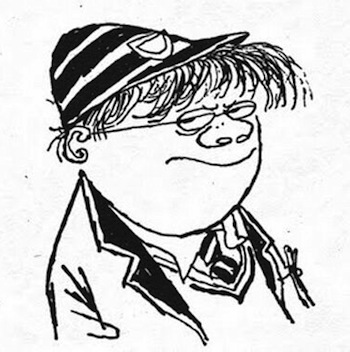
That boy… is Nigel Molesworth.
Nigel Molesworth is a student at an English prep school called St. Custard’s, though he would really rather not be. The self-described “Goriller of 3B,” would prefer to be constructing traps for masters, fighting with his “bro” Molesworth 2, or making ink-darts to hurl at his best friend Peason. Thankfully, even being so busy with all that, Molesworth takes the time to narrate 1950s English school life:
This is me e.g. nigel molesworth the curse of st custard’s which is the school i am at. It is utterly wet and weedy as i shall (i hope) make clear but of course that is the same with all skools.
e.g. they are nothing but kanes, lat. french. geog. hist. algy, geom, headmasters, skool dogs, skool sossages, my bro molesworth 2 and MASTERS everywhere.
The only good things about skool are the BOYS wizz who are noble brave fearless etc. although you hav various swots, bulies, cissies, milksops greedy guts and oiks with whom I am forced to mingle hem-hem.
In fact any skool is a bit of a shambles.
AS YOU WILL SEE.
The creation of St. Trinian’s illustrator Ronald Searle and novelist and essayist Geoffrey Willians, Nigel Molesworth appeared in four novellas published in The Young Elizabethan in the 1950s: Down with Skool!, How to be Topp, Whizz for Atomms, and Back in the Jug Agane. Molesworth narrates them all, and they are presented “unedited,” meaning with his abbreviations and spelling errors. The series is available bundled in two forms: The Compleet Molesworth (1958) and a Penguin volume simply titled Molesworth (2000).
If Hogwarts is the wonder-filled school experience we longed for, then Molesworth’s hilarious essays on life at St. Custard’s give us back our reality. Even if you (like me) did not attend an English prep school in the 1950s, many of Molesworth’s sharp observations still ring true. As an old fan of Harry Potter, encountering Molesworth for the first time earlier this year was revelatory, given that Rowling’s novels draw on Molesworth as much as Tom Brown, a novel which Molesworth was in many ways parodying. It’s a fascinating literary conversation, and one I think fans of Harry Potter will enjoy participating in.
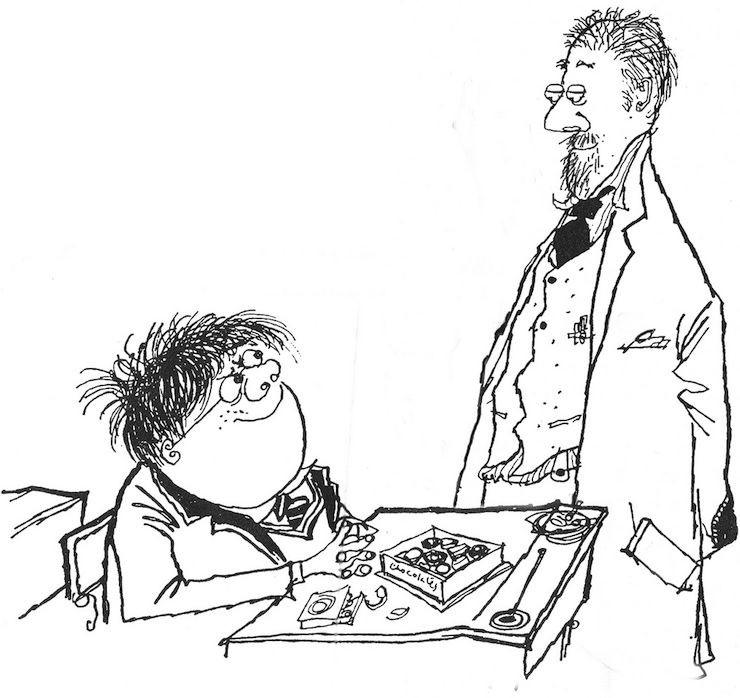
First, let us look at Molesworth himself. Harry and Molesworth are opposites in many ways, not only in their appearances (Molesworth is a bit fat) and their abilities (Harry Potter is not particularly literary, and Molesworth is rotten at all sports). Whereas Harry continuously marvels at the world around him, Molesworth is utterly disillusioned. Here’s a good example from How to be Topp, featuring Porridge Court (a rival school) that may resonate with anyone familiar with Quidditch games:
Hurra! a mighty cheer broke as porridge court scored their eighth gole. With only 5 minits to go the match looked safe for this unsemely colection of huge louts and bulies.
‘Come on st custards,’ sa the footer captain cheerfully. ‘Only 8 goles down. We can do it. Pla up and pla the game.’
‘8 goles?” sa molesworth. ‘Gosh.’
So far he had not touched the ball except to tap it off from the center. He had been the weak link in the chain. Now he determined to pla his natural game. … He scored from all quarters of the field – 2, 3, 4, 5, 6, 7, 8 and, in the last seconds, a mighty crash from a gole kick drove the ball into the porridge court net to win the match. Hurra! The exultant spektators dashed across the field to chair their hero into the pav. . . . .
Poor saps, i supose you believed all that. You lapped it up, eh, like all those skoolboy stories. But life is not like that.
Neither is Molesworth’s best friend a Ron Weasley. Instead, Molesworth has Peason, his “grate frend which means we touough each other up continually.” Peason possesses all of Molesworth’s worst qualities but none of his charm; indeed, he even goes so far as to betray Molesworth to his fellows, when in Back in the Jug Agane Molesworth decides to be “good” (meaning, actually studying, doing homework, and not ruining school property at every opportunity).
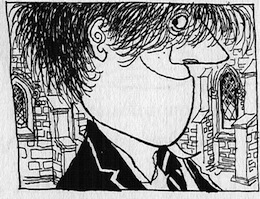
But, as Molesworth would say, wot can you expect? Molesworth’s school and the quality of his companions are not what you find at Hogwarts. At Hogwarts, there is unfairness, yes, and bullies aren’t always punished… but in the end, the brave are rewarded, the loyal are praised, and the just are respected.
At St. Custard’s, the righteous do not always triumph. Molesworth’s enemy is not the enjoyably sniveling Draco Malfoy, but rather the firm-chinned, handsome “Grabber,” who is the winner of “all the races” as well as the dubious “mrs joyful prize for raffia work;” he is also “head of the skool captane of everything,” not necessarily because of his record, but because his parents give St. Custard’s lots of endowments.
When Molesworth decides to be good, he thinks his improved behavior gives him a shot winning the Scrimgeour Kup for Good Karackter (another distinctive name Rowling plucked from Molesworth). Headmaster Grimes claims the prize is “never an easy kup to award,” especially when you take into account Molesworth’s reasoning:
i do not see the dificulty. If you look at the 56 gallant little pupils of st. custards, each of them with his own peculiar ways, it is easy, pappy to devise a SYSTEM. You simply get rid of them this way i.e. there are: 5 squits, 9 snekes, 19 cribbers, 2 maniaks, 3 bookmakers, 4 swots, 11 cig. amokers. Total 53.
Chiz this leaves only one pupil to whom the kup can possibly be awarded.
Unfortunately, Grimes has no hesitation “awarding the kup to GRABBER.” Molesworth is terribly disappointed, but he also knows even at his tender age that “A fat cheque and you can fix anything.”
At Hogwarts, things are at least a bit different. Malfoy, though he tries, cannot use his money and parentage to a similar advantage; even when his father gives brand new broomsticks to the Slytherin Quidditch team, it gets Malfoy his spot as Seeker, but his house does not win their match against Gryffindor. Dumbledore sees through the Malfoys; he must, given their prior allegiances. St. Custard’s’ headmaster, on the other hand, has no reason to see anything other than the Grabbers’ solvency.
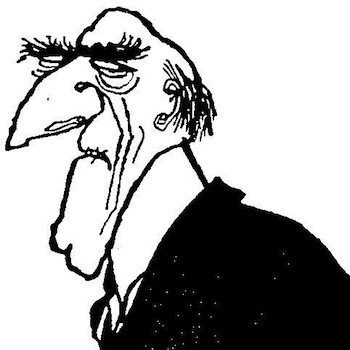
This brings me finally to GRIMES, the dreaded headmaster of St. Custard’s, who makes for rather a dark contrast to Dumbledore. Dumbledore is a vexed figure, equal parts surrogate father and Machiavellian schemer… but whereas his passions are fighting evil and lemon drops, Grimes’ is depicted as someone who mainly enjoys wringing every cent out of his students’ parents, “BEER!” and beating small boys:
‘Now listen, scum,’ he yell, ‘the last mum hav departed in tears. You are in my clutches agane and there is no escape. And its going to be this way this term. More work, increased production, trades unions supresed and the first boy I hear who sa poo gosh at a skool sossage will get 6 [Food at St. Custard’s is hardly the smorgasbord of elf-prepared bacon and treacle tarts one gets at Hogwarts.].’
‘Remember this,’ he leer. ‘You never had it so good.’
While amusing in their own right, the Molesworth novellas also provide a fascinating counterpoint to the Harry Potter novels. Rowling obviously found them inspirational, as well she might—they’re fantastically enjoyable, for any reader who enjoys school stories, as any fule kno. But, I think they are of particular interest for fans of the world of Harry Potter.
And in the end, maybe Nigel and Harry are not so different. Harry is never pleased to leave Hogwarts behind, and neither, we learn, is Molesworth:
Well that is all there is to know about skool but it is alright becos the end of the term is in sight cheers cheers cheers. All boys get together with super rags wheezes japes and pranks. Down with master no more latin no more french no more sitting on the hard old bench no more earwigs in our stew etc. Pillow fights and feasts in the dorm. Noble boys make bonfires of skool books and toast the staff slowly in the flames Charge at everbode and zoom around.
So the buss arrives goodbye to all goodbye to skool pig and skool dog to matron one and all sa hav a good hols we weep with joy. Goodbye headmaster goodbye peason acktually you are joly d. and it is sad to leave. Goodbye to all goodbye.
I should note here that the Molesworth novellas, being written in the 1950s, have their problems. While less overtly racist than one might expect, save for some Cold War paranoia, the gender dynamics are not especially modern. Molesworth’s schoolmate Fotherington-Tomas, though a “super” tennis player, is described as a “cissy,” along with “skipping like a girlie.” That said, Molesworth does come to appreciate Fotherington-Tomas, and is shown up by him more than once; he’s actually one of the best characters in the series, and I believe this is intentional on Willian’s part. Fotherington-Tomas is always a cut above his comrades, and far pithier; says Molesworth: “Anyway his favourite character is little lord fauntleroy and when i sa he hav a face like a tomato he repli i forgive you molesworth for those uncouth words.” So, you are warned.
Molly Tanzer is the author of Vermilion (Word Horde, 2015), and the forthcoming The Pleasure Merchant (Lazy Fascist, 2015), as well as two collections: the Lovecraftian mosaic novel A Pretty Mouth (Lazy Fascist, 2012), and Rumbullion and Other Liminal Libations (Egaeus Press, 2013). Molly lives in Boulder, Colorado, but you can find her on Twitter @molly_the_tanz.










